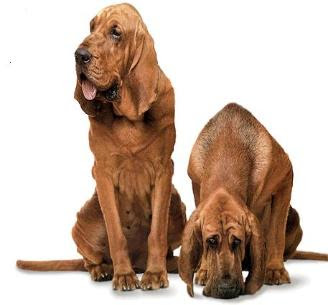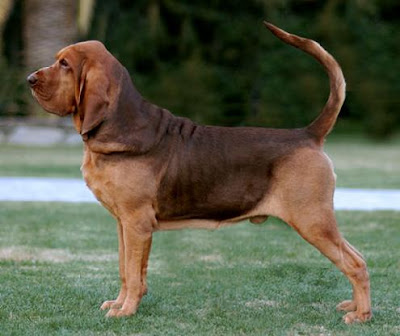Guy is a 2-year old bloodhound and a recent addition to the Clermont County Sheriff’s Department. Technically, he’s not a police dog yet. Guy is in training. He and Summers will be taking the Ohio Peace Officer Training Academy certification test Friday. Summers expects it to go well, and then they’ll be ready for duty. “If something happens two minutes after you get certified, they’ll call you and say, ‘Get over here,’ and we’ll go,” he said. There is no substitute for a bloodhound on a police force, said Cpl. Jim DeCamp, who oversees the Clermont County K-9 training program. They are the main tool to find suspects who have fled from a scene or people who have gone missing.
“The Bloodhound is the best at tracking because it’s the only thing it has to do,” DeCamp said. “Just like in golf, you don’t drive with your putter. You use the best tool for the job.” A police bloodhound won’t be used all the time, said Clermont County Sheriff A.J. Rodenberg. But when it’s important to find someone quickly, there’s no better way to do it. At first glance, Clermont’s new bloodhound appears to be more skin and red fur than actual dog. Guy lumbers across the ground, dragging his face and drooping ears. He looks as if someone took a rough ball of clay and sculpted a dog, but forgot to smooth the edges.
Guy bridges the gap between ugly and adorable. A Bloodhound Dogs unique look is actually part of their overall tracking ability, Summers said. The extra skin helps them trap scent particles. “It gathers the scent from the ground,” he said. “It also shields their eyes. It keeps them from being distracted, keeps them focused.” When working, Guy seamlessly shifts from happy and frolicking to an intensely focused work dog, rapidly shoving his way through the woods when he locks onto the scent. Guy zigzags, pulling at his leash, when trying to locate that smell. It’s an incredibly tricky task, because the scent doesn’t stand still. It’s like a lit cigarette, DeCamp said. The butt might be in one place, but the smoke is being carried in a new direction. In the end, though, it leads to the source.
The training for a bloodhound is intense and constant. The Bloodhound Dog need to keep their searching skills sharp as long as they are on the force. Summers and Guy will go out weekly, if not more often, and hunt a target. In training, someone will hide a distance away. Guy smells something they’ve worn or been near, and begins hunting following the scent. The pair usually trains with another officer, but they’ll use anyone who is willing to help, including Summers’ daughter, Samantha, 16. “You get anybody who will volunteer to sit out in the cold for an hour,” he said. Summers refers to his big dog as “a horse,” but the same description could easily fit for him. The 38-year-old officer is a hulking size, but a mess of blond hair and a wide smile have a way of being disarming.
As the pair barrels through the woods, it’s easy to see why a K-9 unit can calm any situation. “There’s been times when I’ll have three officers on a scene, and a suspect will want to fight. But when it’s a dog, they’ll stop,” DeCamp said. Summers, 38, has never worked with a dog before. He was on road patrol for Clermont County before getting the assignment, and he’ll continue that duty when not with Guy. The K-9 work is now an additional part to his daily job, Summers said. “This is just an exciting assignment,” he said. “I’ve always wanted to do K-9 duty, whether it was a German shepherd or bloodhound. I think it interesting a dog can be used to help police. It’s another tool to do our job.”
Guy might be a police tool, but he’s also become part of Summers’ family in the Loveland area. When Summers clocks out at the end of the day, Guy goes home with him. It’s all part of the bonding experience even if Guy must remain an officer first and a dog second. “He has to be a singleminded animal, that has to be his focus,” said Summers’ wife, April. “I want to love on him and pet him and baby him, but Garry pulls me back. Guy’s an employee of the sheriff’s department, just like Garry.” Guy is the only bloodhound on the force. He was donated by a woman in Dayton. She was going to use Guy as her own tracking dog before realizing he was a little too much to handle.
The official name on Guy’s papers is “Clifford” fitting for a big red dog but the dog never responded to it. His original owner just called him Big Guy, and he seemed to like it, Summers said. The life of a police bloodhound is not an easy one. Clermont’s last dog, Buffy, was with the force 10 years. She was attacked by other dogs, sprayed with Mace, kicked, broke her toes and feet and once even became bloated and had to have her stomach stapled to her rib cage. She was put down in September, suffering from cancer. If any of that happens to Guy, it’s sad, but part of his job, April said. “The purpose he serves is a greater good,” she said. “We’ve got a good pet and a great deputy.”
Summers is working hard to learn his dog’s mannerisms Guy’s actions, body language and mood to figure out when the dog is working and chasing a scent, or playing and chasing a rabbit or deer. “Obviously, the dog doesn’t talk to me, so I have to be able to read what he’s saying,” Summers said. When the time comes, and the pair is needed, Summers knows he and Guy will be prepared. “He’s only 2 years old. He’s got a lot of puppy in him. We need to get to the point where he knows there’s a job to do and gets at it,” Summers said. “But we’ll be ready.”















0 comments:
Post a Comment